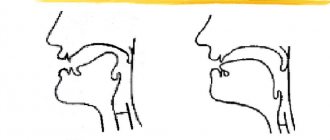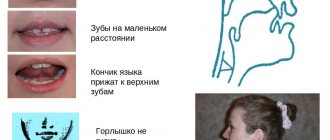Methodology for correcting sound pronunciation
Education and training in general and speech in particular are carried out through classes. Their organization, structure, and use of methodological techniques depend on the diagnosis established by specialists, on the level of impaired psychomotor functions of the child, and largely on the professional level of the speech therapist.
The main principle of work on developing pronunciation skills in children, used by a speech therapist , is the principle of an individual approach. At the same time, a subgroup form of organizing classes is not excluded, especially at the stage of preparing the articulatory apparatus and automating sound in coherent speech.
The second important principle is the use of the child’s compensatory capabilities, relying on intact links (connection of visual, auditory and tactile analyzers).
The third principle is the rational selection of material used in correctional classes. Each lesson should be emotional, developmental and, if possible, educational in nature, and be optimally intense. Not only speech, but also intelligence should develop.
The effectiveness of correctional work depends on the use of various forms and methods of work. The main methods of correctional work of a speech therapist are:
1. Specific (motor-kinesthetic, auditory-visual-kinesthetic) methods. The motor-kinesthetic method involves establishing a connection between the movement of articulatory muscles and their sensation. For example, if a child cannot expose his upper teeth on his own, the speech therapist lifts the child’s upper lip with his index finger. This creates a new sensation - raising the upper lip.
The use of the auditory-visual-kinesthetic method consists in establishing connections between the perception of sound by ear, the visual image of the articulatory pattern and the motor sensation during its pronunciation. To form an auditory-visual image of a sound, the speech therapist demonstrates to the child an articulatory pattern, shows the position of the articulatory structure with the help of his hands, while simultaneously pronouncing the sound. For example, when making the sound [sh], the child is asked to cup his palm and tongue, pronounce the sound and at the same time hold the palm of his hand in the shape of a cup.
2. Didactic methods: - visual; - verbal methods based on visualization; — verbal methods without relying on visualization; - practical methods that should be playful in nature.
Methods and techniques of correctional education should not only correspond to the interests of children and their needs in play, but also ensure the intellectual development of the child, training his thoughts and mind.
Visual techniques - showing toys, pictures, illustrations in books, actions - contribute to the formation of elementary concepts, expanding knowledge about the world around us and developing the ability to generalize.
In correctional work, the principle of multiple presentation of the same subject and speech material in variations should be observed. These could be toys, large pictures, printed board games, illustrations in books. The variety of material will contribute to the formation of generalized ideas about objects. The same visual and verbal material can be used to automate sound in words, then in sentences, phrases, riddles, to compose a descriptive story, etc.
In speech therapy practice, the technique of simultaneous pronunciation of a sound and writing the letter denoting this sound is used (writing and speaking). Children who cannot write are encouraged to pronounce sounds and perform simple actions. For example, pronounce the sound [zh] and move your fingers (“a bug flies, buzzes and flaps its wings”), pronounce the sound [r] and quickly drum your fingers on the table (this is how our tongue hits the “tubercles”), combine the pronunciation of the sound [w] with the movement of a bent palm (“a snake crawls and hisses”).
The following verbal techniques can be distinguished: - verbal sample; - simultaneous pronunciation of sounds by the child and the speech therapist; - repetition; — explanation; - indication; - verbal exercises; - a question as a stimulus for a child’s speech activity; — assessment of children's speech .
Gaming techniques are implemented in the use of various characters, fairy-tale plots, theatricalization, staging (uttering phrases on behalf of characters or animals), inverted words, intentional mistakes, and in the emotional presentation of the material. Children love to correct “mistakes” made by the teacher or character present in the lesson, teach fairy tale guests, and act in some role.
Classes should contain a maximum of information that helps enrich children's memory with images and ideas. A variety of tasks and a fast pace of classes prevent fatigue, develop switching attention and allow children to maintain interest throughout the entire lesson. Structure of individual and subgroup lessons
Individual and subgroup lessons for correcting sound pronunciation at all stages of work may have one general structure, but depending on the stage of work on sound, changes are made to it.
In the preparatory period and at the stage of sound production, more attention is paid to the development of articulatory motor skills, speech-auditory attention, the formation of speech breathing, voice correction, and the development of cognitive processes, while at the stage of sound automation the main thing is the development of the child’s speech activity and the formation of phonemic analysis and synthesis skills.
The proposed structure of classes is based on specific and didactic principles adopted in speech therapy. The structure of individual classes is determined by each speech therapist, based on the individual characteristics of the child, the level of development of articulatory motor skills, speech skills and cognitive processes. For example, articulatory gymnastics and exercises for the development of breathing and voice at the stage of automating sounds in coherent speech are not necessary and are carried out only with those children who need them.
It should be understood that the proposed structure of classes is advisory in nature. It all depends on the situation, and even the mood of the child. For example, when working on a word, it is possible to supplement a sentence with words, jointly compose sentences or a short dialogue, or compose pure proverbs. A speech therapy session is aimed at developing speech and psychomotor functions and consists of several interrelated parts. The sequence of these parts or the structure of classes contributes to the gradual involvement of all brain structures in the work and is the most effective. Let us reveal the essence of each part of the lesson and the variability of the tasks used.
Lesson structure 1. Organizational moment. Relaxation exercises. Plastic studies. Formation of spatial representations. Development of auditory perception. 2. Development of fine motor skills of the fingers. Coordination of movements with speech. 3. Massage or self-massage. 4. Mimic exercises. 5. Articulation gymnastics. Development of fine articulatory movements. Formation of correct articulatory patterns of the lips and tongue. Development of switchability of the organs of the articulatory apparatus. 6. Exercises to develop speech breathing and voice. Coordination of speech with movement. Overcoming violations of syllable structure. 7. Sound production. Development of phonemic awareness. Formation of phonemic analysis and synthesis skills. Development of attention and memory. 8. Automation of sound in syllables. 9. Automation of sound in words. 10. Automation of sound in phrases. 11. Automation of sound in sentences. 12. Automation of sound in pure tongues. 13. Automation of sound in riddles and poems. 14. Automation of sound in independent speech. 15. Teaching storytelling. Development of imagination. 16. Development of cognitive processes (thinking and imagination). 17. Preparing for literacy . Working with letters.
Each part of the lesson provides variability in the tasks used.
Article “Effective ways to correct sound pronunciation in children with speech disorders”
Maryina Ilhame Mamed kyzy
teacher speech therapist
MKDOU kindergarten No. 5 of general developmental type
“Effective ways to correct sound pronunciation in children with speech disorders”
This article is to help educators and parents. After reading it, you will be able to find out what the child’s speech problem is and how to correct it, and prevent him from developing incorrect pronunciation of sounds.
Children of all ages often experience various speech disorders. The most common among them is a violation of the pronunciation of sounds. This disorder can be an independent speech defect, but it can also be part of other, more complex speech disorders, and then, often, it is their most noticeable manifestation.
The speech apparatus with which we speak includes three sections:
Respiratory muscles - necessary for speech.
Vocal folds - their trembling creates the sound of the voice, which is needed to pronounce vowels and voiced consonants.
Speech organs - they are located in the mouth. The main organs of speech are the tongue, lips, lower jaw, teeth, alveoli (tubercles behind the upper teeth), soft palate, and small uvula.
In order to learn to pronounce sounds correctly, it is necessary to form the correct articulation of the lips and tongue, the development of switchability of the organs of the articulatory apparatus, the development of speech breathing and voice, and the development of speech hearing.
One of the most common causes of impaired pronunciation of sounds is insufficient formation of articulatory movements, movements of the pronunciation organs, primarily the tongue, lips, and lower jaw. The movements are not performed clearly enough, their volume is limited, which is why the pronounced sound is distorted. A classic example of such disorders is burr, when a child pronounces the sound [P] not with the tip of the tongue, but by vibration of part of the soft palate - the tongue. In such cases, instead of the desired sound, a sound is pronounced that is absent in the phonetic system of the native language.
It also happens that the sound is not pronounced at all, but is simply absent from speech, instead of the word fish
the child pronounces the word
yba
.
And finally, if a child’s phonemic hearing (hearing for sounds) is not sufficiently developed, then substitutions may be observed in his speech: for example, pronouncing fur coat
the word
suba
, the child does not hear the difference between these two sounds.
Sometimes a child’s speech includes distorted pronunciation, substitutions of sounds, and their absence. These are the most serious violations, the correction of which requires long-term painstaking work.
Training of the pronunciation organs, or articulatory gymnastics, is carried out in order to prepare the speech apparatus for the correct pronunciation of various speech sounds. The sound is pronounced well only when the lips, tongue, and soft palate are sufficiently mobile and work harmoniously and coordinated with each other. Articulatory movements should be quite clear, relaxed, and differentiated.
It is articulation exercises that contribute to the development of correct movements of the articulators, and as a result of these movements, the correct sounds are pronounced.
When performing articulation exercises with your child, do not forget the simple rules.
- Articulatory gymnastics should be carried out in the form of a game.
- In one lesson, a child can be offered to perform no more than three to four exercises.
- There can be no more than two exercises of a new type.
- You can move on to new exercises only after the previous ones have been mastered.
Try to avoid negative assessments; it is better to celebrate the child’s successes.
Lip exercises
- Alternately, form your lips into a tube and stretch them into a smile.
- “Comb” your lower lip with your upper teeth.
- “Comb” your upper lip with your lower teeth.
- Pull both lips into your mouth.
- Retract the corners of your mouth one at a time.
- Pull your lips forward with your proboscis.
- Pull your lips forward with your proboscis and perform circular movements clockwise and counterclockwise.
- Blow through closed lips.
- Alternately bite the lower lip with your upper teeth and your upper lip with your lower teeth.
- Pull your lips in with a whistle, imitating a kiss.
- Smack your lips.
- Silently pronounce the sounds: [a - o - i - u - y - u - i - o - a]
- Repeat the sounds quickly, briefly and clearly: [p]: [p – p – p – p – p]; [m]:[m-m – m – m]; [b]:[b – b – b – b].
- Moo with tightly compressed lips.
- Place a piece of paper on your lips and spit it out.
- Hold the rubber or plastic ring with your lips.
- Hold a narrow straw with your lips, then a wider straw, then a wider diameter straw.
- Suck liquid through a straw.
Exercises for the lower jaw
- Alternately open and close your mouth.
- Lower your lower jaw down and hold it in this position for 5 seconds.
- Slowly open your mouth, hold it in this position for a few seconds, then slowly close it.
- Imitate a yawn.
- Open your mouth slightly, then half-open, open as wide as possible, then also close it gradually.
- Sitting at the table, place your elbows on the table, lower your head into your hands, pressing your chin to your palms. Slowly open and close your mouth.
Tongue exercises
(performed with the mouth open)
- Place the wide part of the tongue on the lower lip and hold the part of the tongue in this position for several seconds.
- Place the narrow part of the tongue on the lower lip and hold the part of the tongue in this position for several seconds.
- Alternately touch the corners of your mouth with the tip of your tongue.
- Raise your tongue to your upper lip.
- Raise your tongue to your upper lip and lower it onto your lower lip.
- Touch the tip of your tongue to your upper teeth.
- Touch the tip of your tongue to the area behind the upper front teeth - the alveoli.
- Alternately stick your tongue out of your mouth and put it back.
- Suck your tongue to the roof of your mouth and hold for 5 seconds.
- Click your tongue.
- Use the wide part of your tongue to lick your upper lip.
- Use the wide part of your tongue to lick your lower lip.
- Run the tip of your tongue along the tops of your teeth in a circle in both directions.
- Brush your teeth from the inside with your tongue.
- “Prick” alternately with your tongue the right and left cheeks from the inside.
- Alternately pinch the wide part of the tongue with your lips and teeth.
- Suck the tongue protruding and clamped between the lips.
- Lick the tablespoon, dessert and teaspoon.
- Use the tip of your tongue to remove a drop from the spoon.
- Roll your tongue into a tube and then spread it on your lower lip.
Exercises for the soft palate
- Open your mouth wide and pronounce the sound [A
].
- Swallow saliva with your mouth closed and lips closed.
- Swallow a few drops of water from the dropper.
- To yawn.
- Cough.
Chewing exercises
Chewing exercises activate the movements of all articulators and develop the skills of transition from one articulatory pose to another.
- Chew with your mouth wide open.
- Chew and talk at the same time.
- Chew and count out loud at the same time.
- Chew and sing vowel sounds: [a – o – y – i – s – e
].
- Chew with your tongue sticking out of your mouth.
- Chew, actively moving your lips and tongue.
Breathing exercises
To correctly pronounce sounds, it is not enough to train the pronunciation organs,
You also need to teach your child to breathe correctly. Breathing exercises are very useful, and the child performs them with interest, since they can be played with.
- Puff out your cheeks and hold the typed sound.
- Pull your cheeks in and relax them.
- Puff out your cheeks and sharply press on them with your fingers (release the air through your lips).
- “Rinse” your mouth with air, rolling it behind your puffy cheeks.
- Blow air alternately from one or the other corner of the mouth.
- It is easy to blow on a feather lying on the table.
- Blow on the cotton wool lying on a smooth surface so that the cotton wool moves.
- Blow on the paper tape to make it flutter.
- Blow on a piece of paper, gradually moving it away from your lips.
- Blow on the confetti to make it rise and fall to the surface.
- As you exhale, slowly pronounce the vowels.
- Blow on the candle to make the flame flicker.
- Blow on light plastic or paper toys floating on the water.
- Blow into the water through a straw, watching for air bubbles that appear.
- Blow bubbles.
- Blow on the candle with your tongue sticking out and blow it out.
- Blow the paper off the tip of your tongue.
- Blow on the bottle with your tongue sticking out.
Basic breathing exercises
"Put the ball into the goal"
(production of a long-lasting, directed air stream).
Pull your lips forward with a tube and blow on the cotton ball for a long time, trying to make it fly between two cubes.
“Who will kick the ball further?”
(production of a smooth, continuous stream running in the middle of the tongue).
Smile and place the wide front edge of your tongue on your lower lip. Blow for a long time so that the air stream goes in the middle of the tongue, and blow the cotton wool onto the opposite edge of the table.
"Blow away a snowflake"
(production of a smooth, targeted air stream of air running down the middle of the tongue).
The mouth is slightly open. Lips in a smile. A wide tongue sticks out. The tip of the tongue is lowered. The lateral edges of the tongue are pressed against the upper teeth. Place a paper square measuring 1x1 cm on the tip of your tongue and blow it off. Make sure that the cheeks do not puff out and the lips do not stretch over the teeth, so that the children seem to pronounce the sound f, not x.
"The engine whistles"
(production of a smooth, continuous stream). Take a clean bottle and bring it to your mouth. Stick out the tip of your tongue slightly so that it only touches the edge of the neck. Exhale air smoothly into the bubble. If the whistle does not work, there is no need to be upset, it means that some rule of the game has not been fulfilled. You should start over.
"Focus", "Parachute"
(direction of the air stream in the middle of the tongue).
Open your mouth slightly, push your tongue forward with a cup and lift it, exhale smoothly onto the cotton wool lying on the tip of your nose, or onto your bangs.
"The Hunter Walks Through the Swamps"
(distribution of the air stream on the sides).
Stretch your lips in a smile, place your tongue between your teeth. As you exhale, slap your cheeks with your palms: you get a squelching sound.
"Bean Race"
(production of a strong, continuous stream running in the middle of the tongue).
The candy box is equipped as a path for runners - “beans”, and they start running with the help of the “wind” from cocktail tubes. The winner is the one who catches his “runner” to the finish line faster.
"Find out what it is"
(development of sense of smell and deep breathing).
On the plates are a piece of lemon or orange, garlic or onion, dry herbs with a characteristic smell and a bottle of perfume. First, smells are studied and memorized, and then objects are guessed from them with eyes closed.
“Whose figurine will fly farther?”
(development of long, smooth exhalation and activation of the lip muscles).
On the tables there are figures of birds, butterflies, flowers, fish, and snowmen cut out of thin paper (or napkins). Each child sits opposite his figurine. You should move the figure only with one exhalation; you cannot blow several times in a row. The signals “fly”, “swim”, “ran” indicate movement for different figures. Some children blow on the figures, while the rest watch.
"Ship"
(alternating strong and long smooth exhalation). You will need a bowl of water and paper boats. In order for the boat to move smoothly, you need to blow on it slowly, with your lips pressed together, as for the sound [f]. To imitate a gusty wind, the lips are folded, as for the sound [p]: “p-p-p”. You can blow by stretching your lips with a tube, but without puffing out your cheeks.
"Peas vs Nuts"
(alternating long, smooth and strong exhalation).
The match is played on a “hockey field” (candy box), “sticks” are cocktail straws. The winner is the one who blows his “players” into the enemy’s goal faster. “Players” (2-3 peas and 2-3 nuts) are pre-scattered throughout the field.
"Bubble"
(development of accuracy of the exhaled stream).
The winner of the competition is the one who blows the biggest bubble or who produces the most bubbles. You need to blow into the ring accurately, otherwise there will be no bubbles.
"New Year's joke tubes"
(development of long, smooth and strong exhalation).
Under the influence of exhaled air, the paper tongue unwinds.
"Inflate the toy"
(development of strong smooth exhalation). Children bring small inflatable toys from home. You should inflate them by taking in air through your nose and slowly exhaling it into the hole of the toy. Then you can play with her.
“Blow through a straw”, “Storm in a glass”
(developing the ability to direct an air stream through the middle of the tongue)
The mouth is open. Lips in a smile. The wide tip of the tongue rests on the bases of the lower incisors. A cocktail straw is placed in the middle of the tongue, the end of which is lowered into a glass of water. Blow through the straw to make the water in the glass bubble. Make sure that your cheeks do not puff out and your lips are motionless.
"We'll grow big."
On the count of “one, two,” rise on your toes, arms to the sides, up, palms inward, stretch—take a deep breath through your nose; on the count of “three, four” - arms down, bending your knees, lean forward - exhale forcefully through your mouth. Repeat at a slow pace 5-6 times.
"Woodcutter"
Starting position - wide stance with legs apart, hands in lock. “One” - raise your arms up, bending at the lower back - take a deep breath through your nose. “Two” - leaning forward, lower your hands sharply down between your legs (imitation of chopping wood) - exhale forcefully through your mouth. “Three” is the starting position. Repeat 7-8 times at a slow pace.
"Geese hiss"
Stand with your feet apart, shoulder-width apart, hands on your waist. “One, two, three, four” - lean forward and, stretching your neck, say with an extended exhalation: “Sh-sh-sh-sh.” Repeat 4-5 times at a slow pace.
"Mower"
Stand with your feet apart, shoulder-width apart, arms slightly bent at the elbows and raised forward, fingers clenched into a fist. Turning right and left, imitating the movements of a mower, make sweeping movements with your arms and say: “Zh-uh! wow!” Repeat 7-8 times at an average pace.
"Sawing wood"
The exercise is performed in pairs.
Stand facing each other, legs apart, left leg forward, hold hands. Leaning forward and alternately bending and straightening your arms at the elbows, imitate sawing wood with your hand movements, while saying: “W-w-w-w.” Repeat for 35-40 seconds at a slow pace
"Locomotive"
Walking in place or around the room with alternating movements with bent arms and simulating the sound of a departing or stopping train: “Wh-hoo! Whaaaah!” Repeat for 35-40 seconds.
"Blow up the balloon"
Stand with your feet apart, holding an imaginary ball in your hands. On the count of “one, two,” take a deep breath through your mouth. On the count of “three, four,” exhale forcefully through the mouth, simulating an expanding ball with hand movements. Repeat 3-4 times at a slow pace.
"Bleed the Air"
Stand with your feet apart, holding an imaginary rubber bladder inflated with air in your hands. On the count of “one, two,” take a deep breath through your mouth; “three, four, five, six” - deflate the air from the chamber with the sound “ssssss!” Repeat 3-4 times at a slow pace.
"Blow on the candle"
Sit on the floor, legs apart, holding an imaginary candle in your hand. On the count of “one, two,” take a deep breath through your nose and mouth; “three, four” - long and slow exhalation, simulating blowing out a candle. Repeat 3-4 times.
Articulatory gymnastics for sonorous sounds (P, Rb, L, L).
1. “Smile – Tube” (development of lip mobility).
Description: Place the upper teeth on the lower ones, stretch the lips in a smile, showing all the teeth, hold the smile for 3 - 5 seconds, stretch the lips forward in a tube, hold the lips in this position for 3 - 5 seconds. Switch from one position to another 5 - 7 times.
Attention: Make sure that the teeth do not open or move during the switching process.
We pull our lips to our ears,
Let's smile at the kids.
And then pull forward
Like a baby elephant's proboscis.
2. “Football” (development of a directed air stream).
Description: Stretch your lips forward with a tube and blow for a long time onto a cotton ball lying on the table in front of the child, driving it into the “gate.”
Attention: Make sure that your cheeks do not puff out; to do this, you can lightly hold them with your fingers. Drive the ball with one exhalation, not allowing the air stream to be intermittent.
I don't puff out my cheeks,
I kick the ball into the goal.
3. “Fungus” (to develop the upper elevation of the tongue, stretching the hyoid ligament).
Description: Smile, show your teeth, open your mouth slightly, and pressing your wide tongue with its entire plane to the palate, open your mouth wide. Then the tongue will resemble a thin mushroom cap, and the stretched hyoid ligament will resemble its stem.
Attention: Make sure your lips are smiling. The side edges of the tongue should be pressed equally tightly - neither half should droop. When repeating the exercise, you need to open your mouth wider.
A big mushroom grew in the forest,
I'll bring a mushroom to the kindergarten.
One two three four five -
I need to hold the mushroom.
4. “Accordion” (strengthening the muscles of the tongue, stretching the hyoid ligament).
Description: Smile, open your mouth slightly, stick your tongue to the roof of your mouth and, without letting go of your tongue, close and open your mouth (just as the bellows of an accordion stretch, so does the hyoid frenulum stretch). When repeating the exercise, you should try to open your mouth wider and wider and keep your tongue in the upper position longer.
Attention: Make sure that your lips remain motionless when opening your mouth. Make sure that when you open your mouth, one side of the tongue does not sag.
We play the harmonica.
We open our mouth wider,
Jaw up, jaw down
Look, don't make a mistake.
5. “Swing” (working on the ability to quickly change the position of the tongue, which is necessary when connecting consonants with vowels).
Description: Smile, show your teeth, open your mouth slightly, put your wide tongue behind your lower teeth (on the inside) and hold it in this position for a count of 1 to 5. Then lift your wide tongue behind your upper teeth (also on the inside) and hold it for a count from 1 to 5. So, alternately change the position of the tongue 4 – 6 times.
Attention: Make sure that only the tongue works, and the lower jaw and lips remain motionless.
Eh, once! Again!
We're rocking now.
Up and down we fly
We don't want to slow down.
6. “Brushing teeth 2” (to lift the tongue up, develop tongue mobility)
Description: Open your mouth and use the tip of your tongue to “brush” the inside of your upper teeth, moving your tongue from side to side.
Attention: The lips are smiling, the upper and lower teeth are visible. Make sure that the tip of the tongue does not protrude or bend inward, but is located at the roots of the upper teeth. The lower jaw is motionless, only the tongue works.
I'll open my mouth a little,
I’ll make my lips a “window.”
Upper teeth - see:
I clean with a “cup” from the inside.
7. “Turkey” (practicing raising the tongue upward, developing mobility of the front part of the tongue).
Description: Open your mouth slightly, place your tongue on the upper lip and move the wide front edge of the tongue along the upper lip back and forth, trying not to lift your tongue from the lip - as if stroking it. First make slow movements, then speed up the pace and add your voice until you hear “bl-bl” (like a turkey).
Attention: Make sure that the tongue is wide and does not narrow. Movement of the tongue should be back and forth, and not from side to side. The tongue should lick the upper lip, and not be thrown forward.
My mouth is wide open
Tongue - back and forth.
Licking his lip with a cup
And chatting while running.
8. “Horse” (strengthening the muscles of the tongue, developing the upward movement of the tongue).
Description: Smile, open your mouth, click the tip of your tongue (like a horse clicking its hooves).
Attention: The exercise is performed slowly. The lower jaw should be motionless, only the tongue works. Make sure that the tip of the tongue does not curl back and up.
Let's gallop, gallop on a horse.
It's very pleasant for us to click.
The rhythm of the hooves beats,
The tongue helps them.
10. “Painter” (practice upward movements of the tongue and its mobility).
Description: Smile, open your mouth and stroke the hard palate with the tip of your tongue, moving your tongue back and forth.
Attention: Lips and lower jaw must be motionless. Make sure that the tip of the tongue reaches the inner surface of the upper teeth as it moves forward, but does not protrude from the mouth.
My tongue is like my brush,
And I paint my palate with it.
11. “Drum” (work on tongue mobility in the upper position).
Description: Smile, open your mouth (wide enough), place your tongue behind your upper teeth, tap your tongue on the roof of your mouth behind your upper teeth with the sound “D-D-D.” Tap the tongue for 7 – 15 seconds (for the entire exhalation).
Attention: Pronounce “d-d-d” often (“like a machine gun”), with effort, straining the muscles not only of the tongue, but also of the neck and shoulders.
We beat the drum
With our tongue.
Loud, loud sound
A loud knock is heard.
12. "Mosquito"
Description: Smile, open your mouth slightly, place your tongue behind your upper teeth and say the sound ZZZ (you will get a sound between Z and Z).
Articulatory gymnastics for hissing sounds (Ш, Ш, Ж, Х).
1. “Smile – Tube” (development of lip mobility).
Description: Place the upper teeth on the lower ones, stretch the lips in a smile, showing all the teeth, hold the smile for 3 - 5 seconds, stretch the lips forward in a tube, hold the lips in this position for 3 - 5 seconds. Switch from one position to another 5 - 7 times.
Attention: Make sure that the teeth do not open or move during the switching process.
We pull our lips to our ears,
Let's smile at the kids.
And then pull forward
Like a baby elephant's proboscis.
2. “Football” (development of a directed air stream).
Description: Stretch your lips forward with a tube and blow for a long time onto a cotton ball lying on the table in front of the child, driving it into the “gate.”
Attention: Make sure that your cheeks do not puff out; to do this, you can lightly hold them with your fingers. Drive the ball with one exhalation, not allowing the air stream to be intermittent.
I don't puff out my cheeks,
I kick the ball into the goal.
3. “Brushing teeth 2” (to lift the tongue up, develop tongue mobility)
Description: Open your mouth and use the tip of your tongue to “brush” the inside of your upper teeth, moving your tongue from side to side.
Attention: The lips are smiling, the upper and lower teeth are visible. Make sure that the tip of the tongue does not protrude or bend inward, but is located at the roots of the upper teeth. The lower jaw is motionless, only the tongue works.
I'll open my mouth a little,
I’ll make my lips a “window.”
Upper teeth - see:
I clean with a “cup” from the inside.
4. “Toffee” (to strengthen the muscles of the tongue and practice the upper elevation of the tongue).
Description: Place the wide tip of your tongue on your lower lip. Place a thin piece of toffee on the very edge of your tongue and glue a piece of candy to the roof of your mouth behind your upper teeth.
Attention: Make sure that the lower jaw is motionless. Open your mouth by 1.5-2 cm. To keep the jaw immobile, you can use an eraser inserted between the molars. Do it slowly.
Oh, how delicious it is
Oh, how sweet it is.
What is this? Toffee?
Or chocolate?
5. “Fungus” (to develop the upper elevation of the tongue, stretching the hyoid ligament).
Description: Smile, show your teeth, open your mouth slightly, and pressing your wide tongue with its entire plane to the palate, open your mouth wide. Then the tongue will resemble a thin mushroom cap, and the stretched hyoid ligament will resemble its stem.
Attention: Make sure your lips are smiling. The side edges of the tongue should be pressed equally tightly - neither half should droop. When repeating the exercise, you need to open your mouth wider.
A big mushroom grew in the forest,
I'll bring a mushroom to the kindergarten.
One two three four five -
I need to hold the mushroom.
6. “Delicious jam” (develop the upward movement of the wide front part of the tongue and the position of the tongue for the sound Ш).
Description: Open your mouth slightly and lick your upper lip with the wide front edge of your tongue, moving your tongue from top to bottom, but not from side to side.
Attention: the lower jaw must be motionless; you can hold it with your finger. The tongue should be wide, the lateral edges of the tongue touching the corners of the mouth. If the exercise does not work, you need to return to the exercise “Punish a naughty tongue,” and the spread tongue can be lifted onto the upper lip with a spatula.
We ate today
Delicious jam
And now in a circle
We'll lick our lips.
7. “Calyx” (develop the correct form of the tongue for pronouncing the sounds Ш, Ж).
Description: Smile, open your mouth slightly, place the wide edge of your tongue on your lower lip (if necessary, spread your tongue by slapping it with your upper lip with the sound “five-five-five”), lift all the edges of the tongue up. Hold for 5-10 seconds.
Attention: Make sure that the tongue is wide, without a pronounced tip of the tongue, all edges of the tongue are evenly raised.
We are seagulls hot
We'll drink at the dacha.
We hold the cup
Stronger, stronger, stronger.
8. “Horse” (strengthening the muscles of the tongue, developing the upward movement of the tongue).
Description: Smile, open your mouth, click the tip of your tongue (like a horse clicking its hooves).
Attention: The exercise is performed slowly. The lower jaw should be motionless, only the tongue works. Make sure that the tip of the tongue does not curl back and up.
Let's gallop, gallop on a horse.
It's very pleasant for us to click.
The rhythm of the hooves beats,
The tongue helps them.
Articulatory gymnastics for whistling sounds (S, S', Z, Z', Ts).
1. “Smile – Tube” (development of lip mobility, formation of the lip pattern necessary for many sounds of Russian speech).
Description: Place the upper teeth on the lower ones, stretch the lips in a smile, showing all the teeth, hold the smile for 3 - 5 seconds, stretch the lips forward in a tube, hold the lips in this position for 3 - 5 seconds. Switch from one position to another 5 - 7 times.
Attention: Make sure that the teeth do not open or move during the switching process.
3. “Spatula” (relaxing the muscles of the tongue, keeping the tongue wide and spread)
Description: The mouth is open, the tongue is calmly placed on the lower lip, and held wide on the lower lip for 3-7 seconds.
Attention: the lower lip should not be tucked in or pulled over the lower teeth. The tongue should be wide, its edges touching the corners of the mouth. Do not stretch your lips into a smile too wide to avoid excess tension.
Our tongue is like a spatula -
Very even, very smooth.
And with such a spatula
And it's fun to dig.
4. “Punish the naughty tongue” (relaxation of the tongue muscles).
Description: Ex. “Spatula”, slap your tongue with your upper lip and say “five-five-five.” Keep your wide tongue in a calm position with your mouth open while counting from 1 to 10.
Attention: You need to pat your tongue with your lips several times in one exhalation. Do not hold in the exhaled air.
The tongue is at fault,
I couldn't say anything.
We'll clap him
Let's spank with sponges.
5. “Score a goal” (production of a smooth, long stream of air running in the middle of the tongue).
Description: Smile, place the wide front edge of the tongue on the lower lip, cover it with the upper lip, leaving a small gap and, as if pronouncing the sound F for a long time, blow the cotton ball onto the opposite edge of the table.
Attention: The lower lip should not be pulled over the lower teeth. You can't puff out your cheeks. Makes sure that the child pronounces F and not X, i.e. so that the air stream is narrow and not diffuse.
I'm an obedient tongue
I turn it into a groove.
I don’t puff out my cheeks,
I kick the ball into the goal.
6. “Brushing your teeth” (learn to hold the tip of your tongue behind your lower teeth).
Description: Smile, show your teeth, open your mouth slightly, and use the tip of your tongue to “brush” your lower teeth, moving your tongue from side to side.
Attention: lips are motionless, in a smiling position. Make sure that the tip of the tongue is at the gums and does not slide along the upper edge of the teeth.
I brush my teeth clean, clean
Both outside and inside;
I want it always
They were white.
7. “Gorka” (learn to hold the tongue in the position necessary for the correct pronunciation of whistling sounds, developing the strength of the muscles of the tip of the tongue).
Description: smile, open your mouth slightly, the tip of your tongue rests under your lower teeth, raise your wide tongue in a “slide.” Hold your tongue for 5-10 seconds.
Attention: make sure that the tip of the tongue does not protrude from behind the teeth; the tongue should be wide. If you don’t succeed right away, ask to pronounce the sound I with your mouth open - your tongue will take the correct position.
We have a long slide!
We'll take a ride now.
Stay on the hill
Smoothly, slowly roll.
Sound pronunciation: correction of violations. Video course for speech therapists
The optimal course for those who want to learn sound pronunciation in children.
► Suitable for:
- beginning speech therapists;
- experienced speech therapists;
- special education teachers
- parents interested in gaining additional knowledge to work with their own children
- students of specialized faculties and professional retraining courses.
► The lectures cover in an accessible form the issues of setting and correcting sound pronunciation in children.
► Logoprofy.ru video lectures can be watched at any convenient time on any device .
► This training format allows you to improve your skills in the shortest possible time, without leaving home .
► You can stop the lecture at any time, review it, or take notes on the material you need.
► After purchasing a video lecture, you are left with a presentation with the main points and exercises , which you can always use in your work.
► The training will be confirmed by a certificate for each, which will be sent to you within three working days.
About the course:
- the course includes 15 video lectures;
- each lecture lasts about 2 hours; total of 30 hours of video;
- The course includes 15 presentations, 1 for each lecture;
- a certificate for the 30-hour course is sent;
Author of the course: Kitayeva Natalya Nikolaevna, candidate of pedagogical sciences, associate professor, speech therapist of the highest qualification category, practitioner with extensive experience.
How is the training going?
After paying for the online course, access to lectures is automatically opened in your personal account on the website, in the “ My orders ” section, the “ Open course ”
Presentations that are shown during each lecture can be downloaded and used in further work.
The course program includes 15 video lectures:
- Production and automation of sounds of early ontogenesis (traditions and innovations) Video lecture No. 1
- Production and automation of sounds of early ontogenesis (traditions and innovations) Video lecture No. 2
- Defects and specifics of correcting the pronunciation of vowels, labial, labial-dental sounds: traditions and innovations.
- These naughty vibrants: violations of the pronunciation of the sounds P, P' and methods for their correction.
- Correction of sound pronunciation disorders. Setting the sounds L, L' from A to Z.
- Correction of sound pronunciation disorders. Making whistling sounds.
- Correction of sound pronunciation disorders. Setting hissing sounds.
- Pronunciation defects and methods of producing back-lingual sounds: traditions and innovations.
- Defects in voicing and softening
- Defects and specifics of correcting the pronunciation of the sound [Y], as well as simple front-lingual sounds ([T], [D], [N], [T'], [D'], [N']: traditions and innovations.
- Study of the state of sound pronunciation in children from 3 to 7 years old. What do parents and aspiring speech therapists need to know?
- Traditional and innovative approaches to correcting violations of the sound-syllable structure of words in children with various disorders. Video lecture No. 1
- Traditional and innovative approaches to correcting violations of the sound-syllable structure of words in children with various disorders. Video lecture No. 2
- Game strategies in overcoming pronunciation defects in preschool children.
- 10 mistakes when setting and automating the sounds P, P'
Duration of each video lecture: 120 minutes.
By purchasing the course, you receive:
— An electronic participant certificate that will be available in your personal account immediately after purchasing the course!
— presentations for video courses that can be used in future work;
The course is available for study in your personal account immediately after payment.
You can watch the recording on mobile devices!








